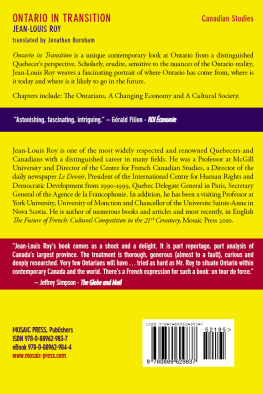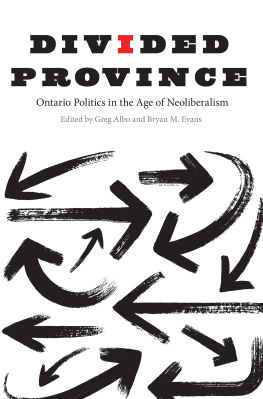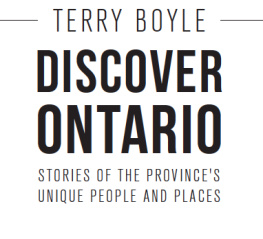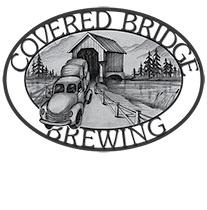MYSTERIES OF ONTARIO
JOHN ROBERT COLOMBO
MYSTERIES OF ONTARIO

Copyright John Robert Colombo 1999
All rights reserved. No part of this publication may be reproduced, stored in a retrieval system, or transmitted in any form or by any means, electronic, mechanical, photocopying, recording, or otherwise (except for brief passages for purposes of review) without the prior permission of Hounslow Press. Permission to photocopy should be requested from the Canadian Copyright Licensing Agency.
Hounslow Press
A Member of the Dundurn Group
Publisher: Anthony Hawke
Editor: Liedewy Hawke
Design: Jennifer Scott
Printer: Transcontinental Printing Inc.
Canadian Cataloguing in Publication Data
Colombo, John Robert 1936
Mysteries of Ontario
ISBN 978-0-88882-205-5
1. Curiosities and wonders Ontario. 2. Disappearances. (Parapsychology) Ontario.
3. Ghosts Ontario. 4. Parapsychology Ontario. I. Title.
BF1472.C3C656 1999 001.9409713 C99-931311-8
1 2 3 4 5 03 02 01 00 99

We acknowledge the support of the Canada Council for the Arts for our publishing program. We also acknowledge the support of the Ontario Arts Council and the Book Publishing Industry Development Program of the Department of Canadian Heritage.
Care has been taken to trace the ownership of copyright material used in this book. The author and the publisher welcome any information enabling them to rectify any references or credit in subsequent editions.
Printed and bound in Canada.

Printed on recycled paper.
Hounslow Press
8 Market Street
Suite 200
Toronto, Ontario, Canada
M5E 1M6
Hounslow Press
73 Lime Walk
Headington, Oxford,
England
OX3 7AD
Hounslow Press
2250 Military Road
Tonawanda, NY
U.S.A. 14150
CONTENTS
Said one, and he the keenest of them all:
No thing is what I vividly recall
O happy man who could remember thus,
The Mystery beyond the mysterious.
A.M. Klein, Of Remembrance, The Collected Poems

The intrinsic mystery is that which remains a
mystery in itself no matter how fully known it
is, and hence is not a mystery separated from
what is known.
Northrop Frye, Second Essay, Anatomy of Criticism
PREFACE
This is a book about the mysteries of Ontario. It takes the form of a guidebook to places in the province that are associated with events and experiences of a supernatural or a paranormal nature. It acts as a directory of the provinces ghosts and spirits, visitations and disappearances, strange customs and peculiar practices, tales and traditions. The book draws together all manner of mysterious lore from the past and the present, cultural matter that has been overlooked by historians and social commentators, yet is kept alive in the regions of the province and in the hearts and minds of its older inhabitants.
Close to five hundred mysteries from the past and the present are described and located in some 250 communities throughout the province. Most of these mysterious places are sites that may be visited. The communities are arranged alphabetically and, wherever appropriate, specific directions are given to locate the mystery or mysteries. Sources are listed for all entries. The bibliography is extensive, and each entry in the bibliography is keyed to its entry or entries in the body of the book.

The author, John Robert Colombo, poses in front of one of the pair of bronze dragons (known as Victorian grotesques) that stood at the foot of the central staircase of Torontos Old City Hall when it opened in 1899. Lost for decades, they were found in a Toronto antique shop by Metropolitan Solicitor George Rust-DEye. Today the dragons guard the entranceway to the Research Hall of the Metro Archives. [Jack Kohane]
Time takes its toll, so many of the sites and monuments that are described in these pages are no longer standing in the province at the present time. Over the years these sites, whether natural or human in nature, may have lost whatever mysterious charge or character they once possessed. Those that have not been altered by time have often suffered change at the hand of man. They may no longer warrant critical interest or contemplative attention, except that of cultural historians who will marvel at how the mundane and the marvellous so often go hand in hand.
The entries in the book are based on the experiences of men and women who live or once lived in this region of Canada. The entries are based on accounts of two kinds. Some events and experiences were reported in the very words of the people who witnessed them. When self-reported, the experiences come to life in a personal way. Other events and experiences were reported by writers journalists, reporters, broadcasters, commentators communicating what they heard from others. Such accounts are fascinating to hear or read, whether they come from oral sources or print sources, whether first-hand or second-hand. For all the sense of verisimilitude, it is important to bear in mind that some accounts are credible and others are... well... incredible. Certain informants are more sophisticated or sceptical than others. It is worth noting that some of the least credible events and experiences are the best reported; some of the most credible ones, poorly reported.
Such subjects as flying saucers and UFOs, alien abductions and conspiracy, ghosts and channelling, ancient mysteries and witchcraft are staples of the tabloids and television, books and movies. Indeed, they never seem to go out of fashion. In the eighteenth and nineteenth centuries, in Upper Canada and in Canada West, our ancestors were delighted to gather around the parlour table or huddle before the hearth to hold each other in thrall with recitals of popular legends, superstitions, folklore, stories of hauntings, and even accounts of the latest mechanical inventions or electrical marvels. The popular press of the past was replete with accounts of nine-day wonders, and they sparked innumerable debates in front of the fireplace.

A.R.G. (George) Owen and Iris M. Owen, British-born para-psychologists, established in Toronto the New Horizons Research Foundation and the Toronto Society for Psychical Research. George researched and wrote Psychic Mysteries of Canada (1975) and Iris collaborated with Margaret Sparrow on Conjuring Up Philip: An Adventure in Psychokinesis (1976). [Isaac Bickerstaff / Don Evans]
William Canniff, the physician and local historian who made his home in Belleville in the mid-nineteenth century, had much to say about the oral nature of the experience of sharing lore and about the reasons for the appeal of the mysterious and the uncanny in his book History of the Settlement of Upper Canada (1869):
Although a few of the settlers had books to read, many had none. And as there were no school teachers very many children grew up without being able to read, or at most very little, and entirely unable to write, unless it might be their name. The writer has been struck with the difference between the composition and penmanship of many of the settlers and that of their immediate children, the former being good, the latter bad; while the parent could write a bold signature, and express himself in writing a letter, intelligently, the offspring either could do nothing of the kind, or else made a very poor attempt. The result of this was, that the mind, starved for want of mental food of a wholesome nature, did not become inactive, but sought other kinds of pabulum. They derived a certain amount of information from the legendary tales told and retold by former days of happiness and plenty. Excluded from the world of literature, and secluded in a forest of eternal silence, except the tones uttered by the voice of nature, sometimes whispering in the gentle murmurs of the sighing wind, and sometimes thundering forth in the loudest voice, shut up with nature they listened to her words, and not educated to understand her meaning, they undertook to interpret her speech, and oftentimes superstition of the deepest kind took possession of their minds. This prevailed perhaps more especially among the Dutch. Belief in ghosts, or spooks was a common thing, and before the bright and flickering light of many a hearth fire, during the winter nights, were told stories which lost nothing in their relating. And along the Bay were many old houses, once the homes of the settler which, it was declared, were occasionally visited by the spirit of the builder, who returned to discharge some duty which rested heavily upon him in the spirit world, or who desired to reveal the place of concealment of some hoarded gold which had been so safely buried in some cranny or nook.
Next page










